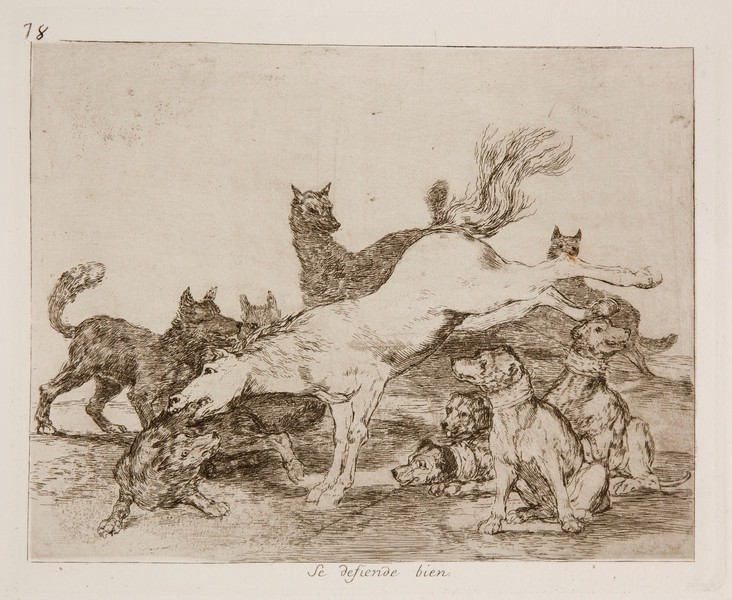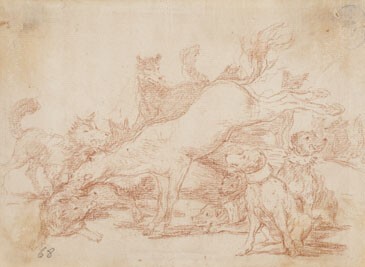- Cronología
- Ca. 1820 - 1823
- Dimensiones
- 179 x 219 mm
- Técnica y soporte
- Etching and burnisher
- Reconocimiento de la autoría de Goya
- Undisputed work
- Ficha: realización/revisión
- 03 Mar 2013 / 24 May 2023
- Inventario
- 225
See Sad forebodings of what is to come.
The first condition test shows traces of burnishing on the horse's belly.
The title of the print was handwritten by Goya on the first and only series known to us at the time of its production, which the painter gave to his friend Agustín Ceán Bermúdez. Thus the title was subsequently engraved on the plate without any modification from Ceán Bermúdez's copy for the first edition of the Disasters of War published by the Royal Academy of Fine Arts of San Fernando in Madrid in 1863.
A preparatory drawing of this engraving is in the Prado Museum
In the centre of this picture, a white horse is throwing a blow. All around him are mastiffs, identifiable by the iron-tipped collars they wear to defend themselves against the wolves, who watch the horse's violent reaction undaunted. In the background of the picture, a pack of wolves is preparing to attack the horse.
Each of these three animals has its own symbolic meaning. The dogs could refer to revolutionary ideals, while the wolves have often been associated with the Inquisition; indeed Ruiz Padrón imagined the inquisitors as a pack of hungry wolves. The horse, however, could be an allusion to liberal Spain. In this way Goya might be thought to have captured the efforts that the constitutional monarchy was making to defend itself, on the one hand from the values of the Ancien Régime, and on the other from revolutionary impulses.
In any case, it should be pointed out that this engraving, like many others in the Emphatic Caprices, , is quite complex and can be interpreted in other ways. Eleanor Sayre, for example, draws a comparison between the horse in Goya's print and the one in Guernica (1937, National Museum and Art Centre Reina Sofía) by Pablo Picasso (Malaga, 1881-Mouguins, 1973), and believes that both artists use it to allude to the Spanish people who, in the present case, are being attacked by the followers of Ferdinand VII.
Juliet Wilson-Bareau also relates this print to the poem by Giambattista Casti (Viterbo or Acquapendente, 1724-Paris, 1803) Gli animali parlanti (1801) in which the horse is a symbol of monarchy fighting against the wolves, the king's corrupt ministers, although without the help of the dogs, who represent the anti-monarchist forces of the revolution.
This is an engraving in which Goya has captured the centrifugal force of the horse stretching out to throw its legs into the air. The intense energy of this animal could be related to engraving no. 8, Always Happens from The Disasters of War, a series in which the horse is involved in a scene of enormous intensity.
The plate is in the National Chalcography (cat. 329).
-
De grafiek van GoyaRijksmuseum RijksprentenkabinetAmsterdam1970from November 13th 1970 to January 17th 1971cat. 88
-
Goya y el espíritu de la IlustraciónMuseo Nacional del PradoMadrid1988from October 6th to December 18th 1988. Exhibited also at Museum of Fine Arts, Boston, January 18th to March 26th 1989; The Metropolitan Museum of Art, Nueva York, May 9th to July 16th 1989, Madrid curator Manuela B. Mena Marqués, scientific directors Alfonso E. Pérez Sánchez and Eleanor A. Sayrecat. 160
-
Francisco de GoyaMuseo d'Arte ModernaLugano1996exhibition celebrated from September 22nd to November 17th.p.195, cat. 78
-
Francisco Goya. Sein leben im spiegel der graphik. Fuendetodos 1746-1828 Bordeaux. 1746-1996Galerie KornfeldBern1996from November 21st 1996 to January 1997cat. 168
-
Francisco Goya. Capricci, follie e disastri della guerraSan Donato Milanese2000Opere grafiche della Fondazione Antonio Mazzottacat. 158
-
Goya et la modernitéPinacothèque de ParisParís2013from October 11st 2013 to March 16th 2014cat. 117
-
Madrid2017
-
Goya, grabadorMadridBlass S.A.1918cat. 180
-
Goya engravings and lithographs, vol. I y II.OxfordBruno Cassirer1964cat. 198
-
Vie et ouvre de Francisco de GoyaParísOffice du livre1970cat. 1130
-
A solution to the enigma of Goya’s emphatic caprices nº 65-80 of The Disasters of WarApollo1978pp.186-191
-
Goya y el espíritu de la IlustraciónMadridMuseo del Prado1988pp.445-446. cat. 160
-
Catálogo de las estampas de Goya en la Biblioteca NacionalMadridMinisterio de Educación y Cultura, Biblioteca Nacional1996cat. 303
-
Francisco de Goya. Los Desastres de la guerraBarcelonaLa Central2011p.44
-
ParísPinacoteca de París2013p. 158
-
Goya. In the Norton Simon MuseumPasadenaNorton Simon Museum2016pp. 114-151
-
ZaragozaGobierno de Aragón y Fundación Bancaria Ibercaja2017p. 202

